[English] 日本語
 Yorodumi
Yorodumi- PDB-2mrk: Fyn SH2 domain in complex with the natural inhibitory phosphotyro... -
+ Open data
Open data
- Basic information
Basic information
| Entry | Database: PDB / ID: 2mrk | ||||||
|---|---|---|---|---|---|---|---|
| Title | Fyn SH2 domain in complex with the natural inhibitory phosphotyrosine peptide | ||||||
 Components Components |
| ||||||
 Keywords Keywords | TRANSFERASE / phosphorylated peptide / Fyn kinase / SH2 domain / Src kinase | ||||||
| Function / homology |  Function and homology information Function and homology informationnegative regulation of hydrogen peroxide biosynthetic process / response to singlet oxygen / Reelin signalling pathway / perinuclear endoplasmic reticulum / NTRK2 activates RAC1 / regulation of glutamate receptor signaling pathway / heart process / Activated NTRK2 signals through FYN / SEMA3A-Plexin repulsion signaling by inhibiting Integrin adhesion / regulation of calcium ion import across plasma membrane ...negative regulation of hydrogen peroxide biosynthetic process / response to singlet oxygen / Reelin signalling pathway / perinuclear endoplasmic reticulum / NTRK2 activates RAC1 / regulation of glutamate receptor signaling pathway / heart process / Activated NTRK2 signals through FYN / SEMA3A-Plexin repulsion signaling by inhibiting Integrin adhesion / regulation of calcium ion import across plasma membrane / reelin-mediated signaling pathway / Platelet Adhesion to exposed collagen / CRMPs in Sema3A signaling / G protein-coupled glutamate receptor signaling pathway / FLT3 signaling through SRC family kinases / activated T cell proliferation / positive regulation of protein localization to membrane / type 5 metabotropic glutamate receptor binding / CD4 receptor binding / Nef and signal transduction / cellular response to L-glutamate / feeding behavior / Co-stimulation by CD28 / Nephrin family interactions / DCC mediated attractive signaling / EPH-Ephrin signaling / natural killer cell activation / negative regulation of dendritic spine maintenance / Ephrin signaling / CD28 dependent Vav1 pathway / dendritic spine maintenance / growth factor receptor binding / cellular response to peptide hormone stimulus / tau-protein kinase activity / Regulation of KIT signaling / leukocyte migration / phospholipase activator activity / Co-inhibition by CTLA4 / EPHA-mediated growth cone collapse / dendrite morphogenesis / peptide hormone receptor binding / CD8 receptor binding / Dectin-2 family / stimulatory C-type lectin receptor signaling pathway / Fc-gamma receptor signaling pathway involved in phagocytosis / forebrain development / PECAM1 interactions / response to amyloid-beta / cellular response to glycine / FCGR activation / Sema3A PAK dependent Axon repulsion / EPH-ephrin mediated repulsion of cells / glial cell projection / CD28 dependent PI3K/Akt signaling / positive regulation of protein targeting to membrane / Role of LAT2/NTAL/LAB on calcium mobilization / negative regulation of extrinsic apoptotic signaling pathway in absence of ligand / ephrin receptor signaling pathway / vascular endothelial growth factor receptor signaling pathway / detection of mechanical stimulus involved in sensory perception of pain / alpha-tubulin binding / cellular response to transforming growth factor beta stimulus / postsynaptic density, intracellular component / negative regulation of oxidative stress-induced intrinsic apoptotic signaling pathway / T cell receptor binding / phosphatidylinositol 3-kinase binding / phospholipase binding / GPVI-mediated activation cascade / ephrin receptor binding / T cell costimulation / cellular response to platelet-derived growth factor stimulus / Signaling by ERBB2 / negative regulation of protein ubiquitination / EPHB-mediated forward signaling / NCAM signaling for neurite out-growth / CD209 (DC-SIGN) signaling / FCGR3A-mediated IL10 synthesis / axon guidance / cell surface receptor protein tyrosine kinase signaling pathway / Antigen activates B Cell Receptor (BCR) leading to generation of second messengers / peptidyl-tyrosine phosphorylation / Signaling by phosphorylated juxtamembrane, extracellular and kinase domain KIT mutants / negative regulation of angiogenesis / Cell surface interactions at the vascular wall / learning / non-membrane spanning protein tyrosine kinase activity / FCGR3A-mediated phagocytosis / actin filament / Regulation of signaling by CBL / non-specific protein-tyrosine kinase / negative regulation of inflammatory response to antigenic stimulus / protein catabolic process / Signaling by SCF-KIT / G protein-coupled receptor binding / positive regulation of neuron projection development / negative regulation of protein catabolic process / modulation of chemical synaptic transmission / positive regulation of protein localization to nucleus / VEGFA-VEGFR2 Pathway / tau protein binding Similarity search - Function | ||||||
| Biological species |  Homo sapiens (human) Homo sapiens (human) Homo Sapiens (human) Homo Sapiens (human) | ||||||
| Method | SOLUTION NMR / simulated annealing, simulated annealing | ||||||
| Model details | closest to the average, model1 | ||||||
 Authors Authors | Huculeci, R. / Buts, L. / Lenaerts, A.J. / van Nuland, N. | ||||||
 Citation Citation |  Journal: Structure / Year: 2016 Journal: Structure / Year: 2016Title: Dynamically Coupled Residues within the SH2 Domain of FYN Are Key to Unlocking Its Activity. Authors: Huculeci, R. / Cilia, E. / Lyczek, A. / Buts, L. / Houben, K. / Seeliger, M.A. / van Nuland, N. / Lenaerts, T. | ||||||
| History |
|
- Structure visualization
Structure visualization
| Structure viewer | Molecule:  Molmil Molmil Jmol/JSmol Jmol/JSmol |
|---|
- Downloads & links
Downloads & links
- Download
Download
| PDBx/mmCIF format |  2mrk.cif.gz 2mrk.cif.gz | 940.5 KB | Display |  PDBx/mmCIF format PDBx/mmCIF format |
|---|---|---|---|---|
| PDB format |  pdb2mrk.ent.gz pdb2mrk.ent.gz | 784 KB | Display |  PDB format PDB format |
| PDBx/mmJSON format |  2mrk.json.gz 2mrk.json.gz | Tree view |  PDBx/mmJSON format PDBx/mmJSON format | |
| Others |  Other downloads Other downloads |
-Validation report
| Summary document |  2mrk_validation.pdf.gz 2mrk_validation.pdf.gz | 379.5 KB | Display |  wwPDB validaton report wwPDB validaton report |
|---|---|---|---|---|
| Full document |  2mrk_full_validation.pdf.gz 2mrk_full_validation.pdf.gz | 552 KB | Display | |
| Data in XML |  2mrk_validation.xml.gz 2mrk_validation.xml.gz | 47.7 KB | Display | |
| Data in CIF |  2mrk_validation.cif.gz 2mrk_validation.cif.gz | 79.3 KB | Display | |
| Arichive directory |  https://data.pdbj.org/pub/pdb/validation_reports/mr/2mrk https://data.pdbj.org/pub/pdb/validation_reports/mr/2mrk ftp://data.pdbj.org/pub/pdb/validation_reports/mr/2mrk ftp://data.pdbj.org/pub/pdb/validation_reports/mr/2mrk | HTTPS FTP |
-Related structure data
| Related structure data |  2mqiC  2mrjC C: citing same article ( |
|---|---|
| Similar structure data | |
| Other databases |
|
- Links
Links
- Assembly
Assembly
| Deposited unit | 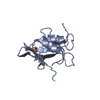
| |||||||||
|---|---|---|---|---|---|---|---|---|---|---|
| 1 |
| |||||||||
| NMR ensembles |
|
- Components
Components
| #1: Protein | Mass: 11690.341 Da / Num. of mol.: 1 / Fragment: UNP residues 149-248 Source method: isolated from a genetically manipulated source Source: (gene. exp.)  Homo sapiens (human) Homo sapiens (human)Description: The SH2 domain from human p59fyn is represented by residues 149-248. Gene: FYN / Production host:  References: UniProt: P06241, non-specific protein-tyrosine kinase |
|---|---|
| #2: Protein/peptide | Mass: 1254.195 Da / Num. of mol.: 1 / Fragment: UNP residues 528-537 / Source method: obtained synthetically Details: The natural inhibitory peptide is a 10-residue phosphotyrosine segment from the C-terminal region of the Fyn kinase. Source: (synth.)  Homo Sapiens (human) Homo Sapiens (human)References: UniProt: P06241, non-specific protein-tyrosine kinase |
| Has protein modification | Y |
-Experimental details
-Experiment
| Experiment | Method: SOLUTION NMR | ||||||||||||
|---|---|---|---|---|---|---|---|---|---|---|---|---|---|
| NMR experiment |
|
- Sample preparation
Sample preparation
| Details | Contents: 0.93 mM [U-99% 13C; U-99% 15N] protein_1, 1.2 mM protein_2, 93% H2O/7% D2O Solvent system: 93% H2O/7% D2O | ||||||||||||
|---|---|---|---|---|---|---|---|---|---|---|---|---|---|
| Sample |
| ||||||||||||
| Sample conditions | Ionic strength: 0 / pH: 6.5 / Pressure: ambient / Temperature: 298 K |
-NMR measurement
| NMR spectrometer |
|
|---|
- Processing
Processing
| NMR software |
| ||||||||||||||||||||||||
|---|---|---|---|---|---|---|---|---|---|---|---|---|---|---|---|---|---|---|---|---|---|---|---|---|---|
| Refinement | Method: simulated annealing, simulated annealing / Software ordinal: 1 / Details: HADDOCK runs under CNS | ||||||||||||||||||||||||
| NMR representative | Selection criteria: closest to the average | ||||||||||||||||||||||||
| NMR ensemble | Conformer selection criteria: structures with the lowest energy Conformers calculated total number: 200 / Conformers submitted total number: 27 |
 Movie
Movie Controller
Controller


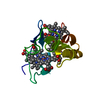
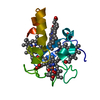
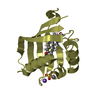
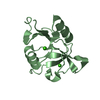

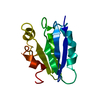
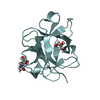
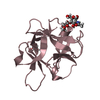

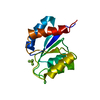
 PDBj
PDBj












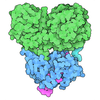






 NMRPipe
NMRPipe